The future of religion in the Philippines is undergoing significant changes driven by demographic shifts and emerging movements.
The country's religious landscape is currently dominated by Catholicism, with over 80% of the population identifying as Catholic. However, smaller sects and fundamentalist groups are gaining popularity among the youth.
By 2050, Christians are projected to represent around 92% of the population, but the Muslim demographic is also growing.
Globalization is fostering religious pluralism, which is affecting religious engagement and identity. For instance, the increasing exposure to different beliefs and practices is leading to a more diverse and complex religious landscape.
The Catholic Church's efforts in social justice are crucial in addressing contemporary issues, such as poverty, inequality, and environmental degradation.
The Church's advocacy for social justice is expected to play a significant role in shaping the country's spiritual landscape in the coming years.
Historical Context of Religion
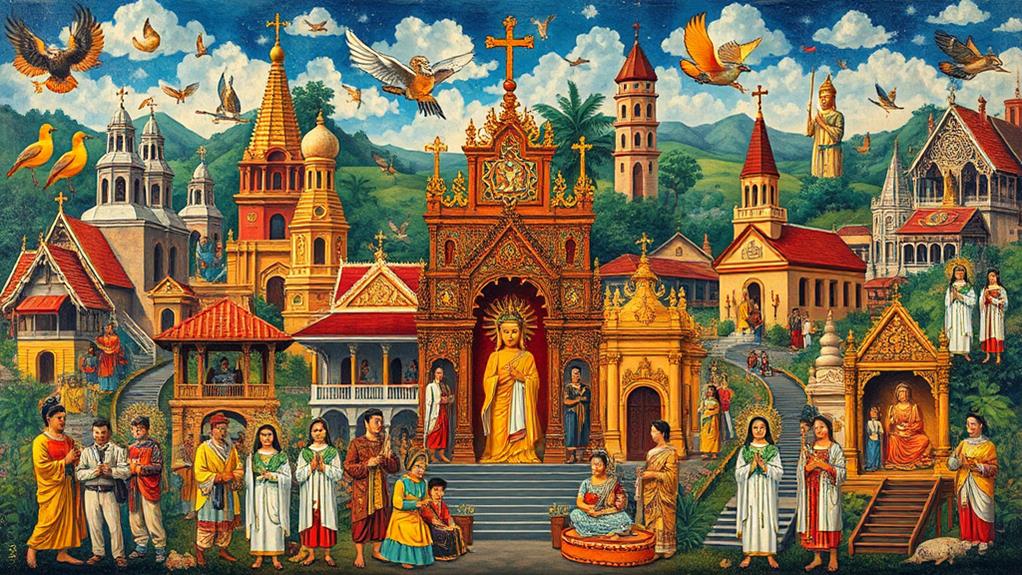
Religion in the Philippines has undergone significant transformations due to foreign and local influences.
The introduction of Islam around 1350 marked the first major foreign religion, particularly impacting Mindanao and Sulu. This early influence laid the groundwork for a diverse religious landscape.
Spanish colonization in 1565 led to the systematic introduction of Christianity, primarily through the Catholic Church. By 1579, Manila had become a bishopric, establishing ecclesiastical structures that would dominate the religious scene.
In the 18th century, the Catholic Church's influence grew, blending folk Christianity with indigenous practices, especially in rural areas. Parish priests became integral to community life, reinforcing the Church's role as a social and spiritual authority.
The American colonial period introduced Protestantism, aiming to Christianize and democratize the population through education. This shift led to the emergence of various nationalized churches during the rebellion against Spain.
Post-war recovery saw the Catholic Church rebuild and adapt to modern challenges, increasing laity participation while maintaining its influence in socio-political issues.
This historical context is crucial for anticipating the future of religion in the Philippines.
Current Religious Landscape
In the Philippines, 85% of the population considers religion a vital part of their daily lives, with 70% attending religious services at least once a month. This strong religious commitment shapes the nation's diverse religious demographics.
The Catholic Church dominates the religious landscape, accounting for over 80% of the population. However, it faces challenges from the rise of smaller sects and fundamentalist groups.
Three key aspects of the current religious landscape are:
Protestant Growth: The Protestant population, including various sects, has been increasing. For instance, although historically significant groups like the Aglipayans have dwindled to about 5%, other Protestant groups are growing.
Muslim Population: The Muslim population is projected to rise from 5.5% to 6% by 2050, indicating subtle shifts in the broader religious demographics.
Social Engagement: The Catholic Church actively participates in social action and human rights initiatives, reflecting its engagement with socio-political issues.
This engagement influences both religious practices and societal norms in the Philippines.
Demographic Changes Ahead
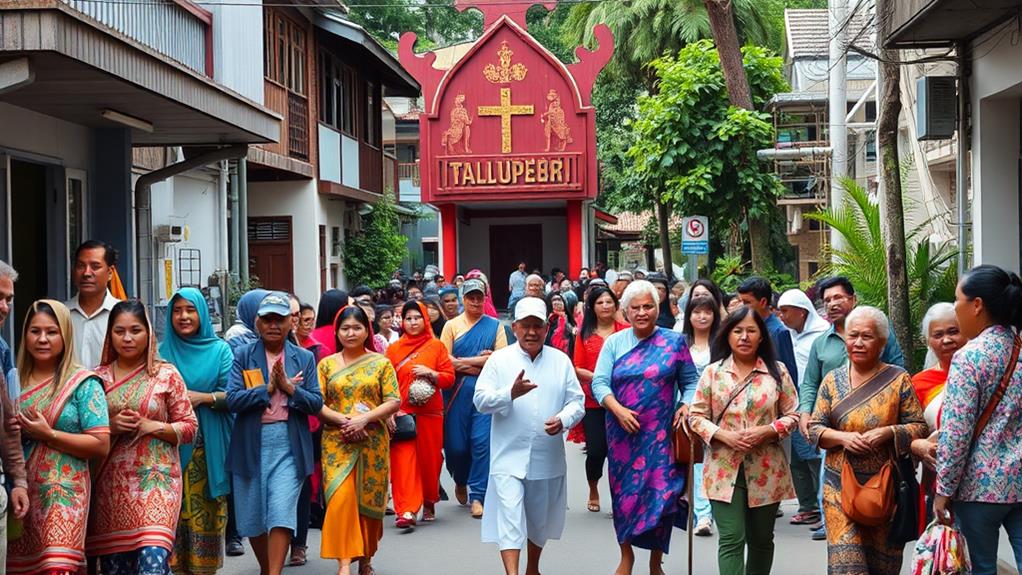
The Philippines' Christian majority will persist, but demographic changes are expected to alter the religious landscape.
By 2050, the country's Christian population is projected to reach approximately 143.55 million, comprising 92% of the population. Although Christians will remain the majority, their percentage will decrease slightly from 92.6% in 2010. This indicates a gradual growth in the Muslim population, which is predicted to rise from 5.5% to 6% over the same period.
The Philippines' ranking as the fifth largest Christian population in the world makes these shifts significant. The Pew Research Center's projections suggest that globally, the numbers of Christians and Muslims will approach parity, with implications for interfaith relations and societal cohesion.
The Vatican's focus on the Philippines highlights its strategic importance, which could influence community engagement and religious discourse.
Understanding demographic changes is crucial for anticipating future trends in spirituality and religious practices. The interplay between Christianity and Islam in a predominantly Christian nation will be affected, making it essential to recognize these shifts to prepare for their impact.
Rise of New Religious Movements
New Religious Movements Emerge in the Philippines
The Philippine religious landscape is undergoing a significant transformation, as new religious movements emerge and challenge the traditional dominance of the Catholic Church.
Diverse Sects Gain Followers
Various sects have appeared, with some gaining significant followings. For instance, some sects have designated national heroes as divine figures, attracting a large number of devotees.
These sects often blend traditional Filipino beliefs with modern spiritual practices, appealing to those seeking alternative forms of worship.
Grassroots Involvement Increases
There is a notable increase in grassroots participation in religious activities.
Laity and local clergy are actively engaging in church activities to address contemporary social issues, such as poverty and inequality.
This shift towards community-based initiatives reflects a growing desire for religious practices that are more relevant to everyday life.
Fundamentalist Groups Gain Traction
Fundamentalist groups are gaining popularity, particularly among younger generations seeking new forms of religious engagement that diverge from traditional Catholicism.
These groups often emphasize personal spirituality and moral values, appealing to those seeking a more individualized religious experience.
The socio-political context of the Philippines, shaped by historical tensions and colonial legacy, has created a fertile ground for these new religious movements.
As these movements continue to evolve, they contribute to a diverse and dynamic religious landscape, ensuring that the future of religion in the Philippines remains complex and multifaceted.
Impact of Globalization
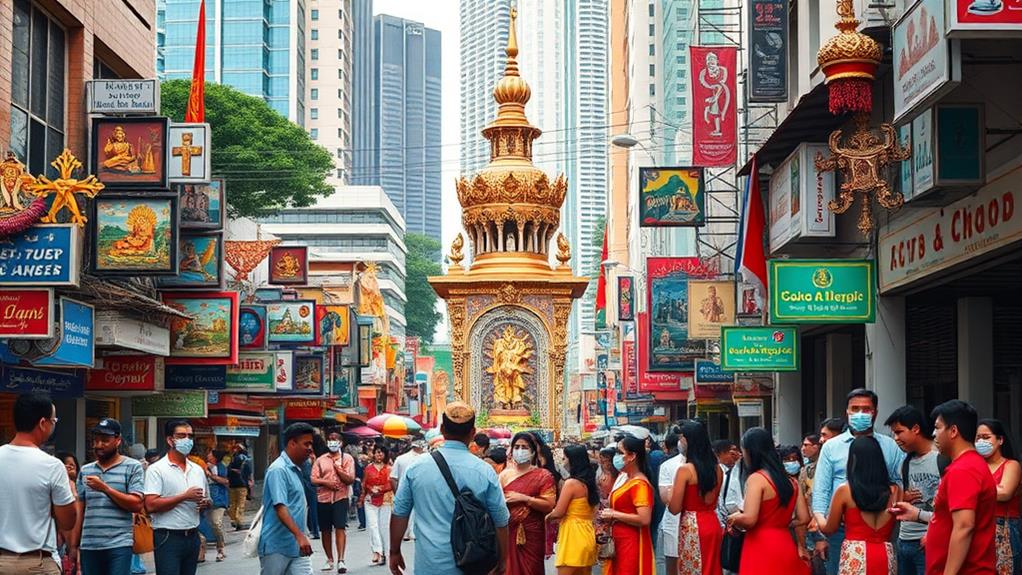
Globalization is transforming the religious landscape in the Philippines. This shift enables diverse beliefs and practices to flourish, contributing to the growth of small sects and alternative spiritual movements that challenge Catholicism's long-standing dominance.
Global connectivity facilitates the spread of religious ideas. The rise of fundamentalist groups and online religious communities significantly influences younger generations' engagement with traditional religious practices. For instance, social media platforms allow individuals to connect with like-minded groups worldwide, exposing them to new religious ideas and practices.
Economic globalization plays a vital role in reshaping local religious landscapes. As Filipino workers migrate abroad, they exchange religious ideas and practices, which they bring back upon their return. This exchange leads to the introduction of new religious practices and the blending of various traditions.
Global cultural trends promote visibility and acceptance of minority faiths. Social media and international religious events encourage greater understanding and acceptance of diverse religious beliefs.
This interaction between local and global influences fosters a more pluralistic society, where syncretism and the blending of various religious traditions are increasingly common.
Role of Religion in Society
Religion plays a vital role in shaping Filipino society, with approximately 85% of Filipinos considering religion important. This significant influence extends beyond spirituality, impacting cultural practices, social norms, and community events.
Social Justice Initiatives are a key aspect of the Catholic Church's role in society. The Church actively engages in socio-political issues, advocating for social justice and human rights through programs like Basic Ecclesial Communities (BECs).
For instance, BECs provide a platform for Catholics to discuss and address social issues, such as poverty and inequality.
The Diverse Religious Landscape in the Philippines is another important aspect of religion's role in society. While Catholicism remains the dominant religion, accounting for over 60% of the population, the rise of various religious sects reflects a diversification of religious expression.
This shift challenges the Catholic Church's supremacy and invites broader discussions on faith.
Religion also plays a crucial role in Community Engagement. Educational initiatives and community programs by religious organizations foster cultural understanding and address pressing social issues.
For example, religious organizations provide disaster relief, healthcare services, and education to marginalized communities, demonstrating how religion can serve a practical role in society.
Secularism and Religious Identity
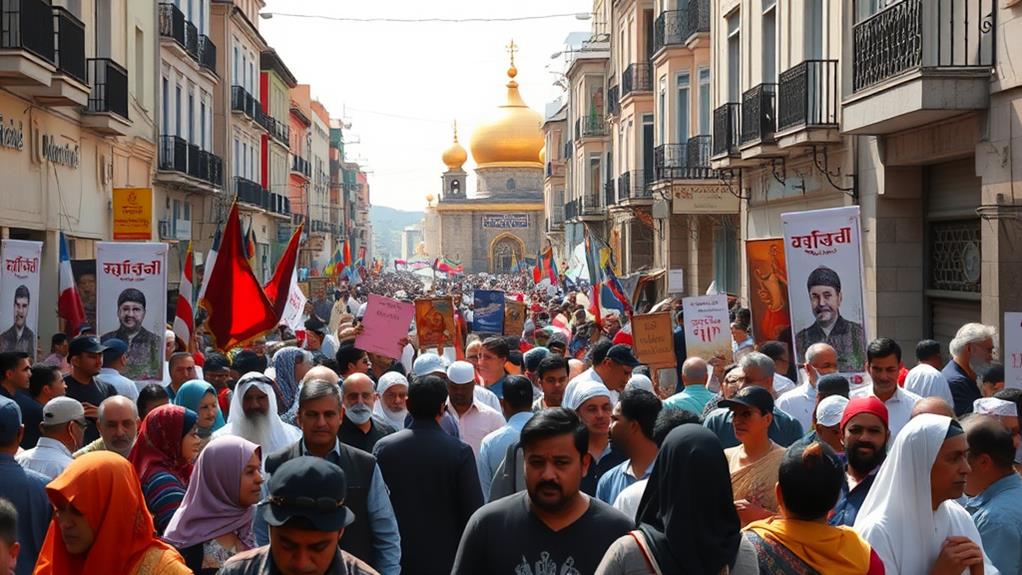
The Philippines is experiencing a significant shift in religious identity, particularly among younger generations.
A recent study reveals that 85% of Filipinos still consider religion important, but this sentiment is decreasing among younger demographics. This decline is driven by globalization and exposure to diverse belief systems, which encourages religious pluralism. As a result, younger Filipinos are exploring alternative spiritual practices, causing traditional religious narratives to lose appeal.
The Catholic Church is facing challenges in maintaining engagement with the laity, especially in urban areas. The emergence of small sects and fundamentalist groups poses a threat to the Catholic Church's dominance, further diversifying the religious identity landscape.
This shift towards secular values reflects a broader transformation in the country's spiritual fabric.
The interplay between secularism and religious identity is reshaping the Philippines' religious landscape in significant ways. This transformation is characterized by a decline in traditional religious adherence and an increased interest in secularism, ultimately leading to a more diverse and complex religious identity landscape.
How Will the Future of Religion in the Philippines Impact Education?
The future of religion in philippines education is a topic of growing importance. As the country becomes more diverse, it’s essential for education to embrace different religious beliefs and teachings. Understanding and respecting the various religions will promote tolerance and inclusivity in the educational system.
Future Challenges and Opportunities
Future challenges and opportunities are emerging in the Philippines' religious landscape as demographic shifts and societal changes unfold.
Increasing Muslim Population: By 2050, Muslims are expected to make up 6% of the Philippine population, up from 5.5% today.
This growth will likely lead to greater interfaith dialogue and require major religious institutions to adopt a more inclusive approach.
Native Clergy's Growing Influence: The rise of grassroots movements and increased participation of native clergy presents both challenges and opportunities.
Local leaders will address community needs more directly, enhancing relevance, but potentially challenging traditional hierarchies.
Adapting to Societal Dynamics: Although the Christian population will remain the largest globally, its percentage will decline slightly.
To remain relevant, religious organizations must adapt to modern societal dynamics and the diverse needs of their congregations, fostering a more responsive and engaged faith community.
Predictions for 2050
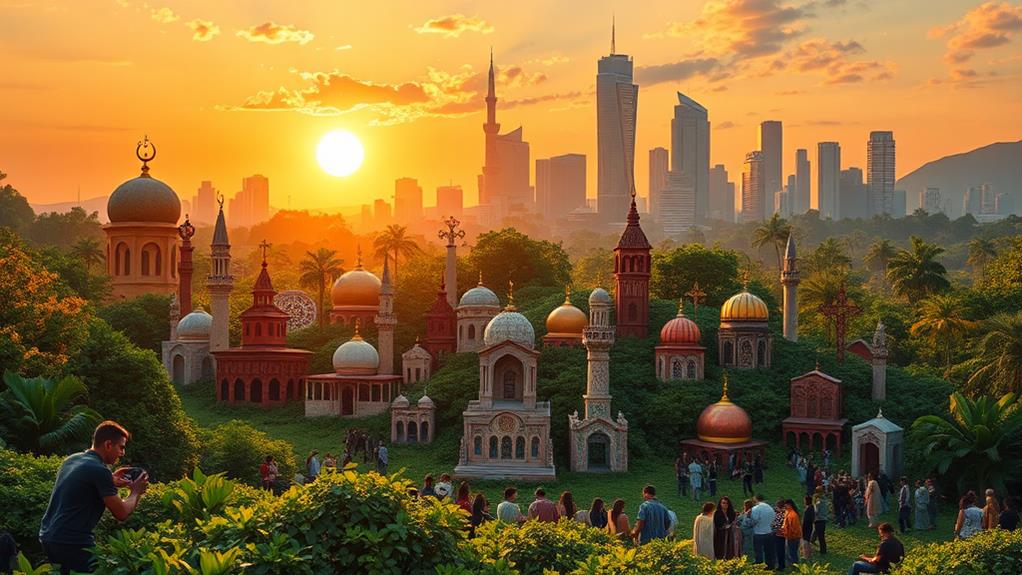
By 2050, the Philippines will remain a significant player in the global religious landscape. The country is expected to have approximately 143.55 million Christians, making it the fourth largest Christian population globally, representing about 4.9% of the world's total Christian demographic.
Although Christians will still make up 92% of the Philippine population, this marks a slight decrease from 92.6% in 2010, indicating subtle demographic shifts.
The Muslim population is expected to increase from 5.5% to 6%, suggesting that by 2050, the number of Muslims will nearly equal the growth of Christians in some regions.
Globally, the Christian population will reach nearly 2.9 billion, with Muslims approaching 2.8 billion, indicating a shift toward near parity between these two major religions.
As Asia's most predominantly Christian country, the Philippines is poised to remain a focal point for religious leadership and community engagement.
The evolving demographics will have significant implications for outreach efforts and interfaith dialogue, shaping the future of religion in the nation as it adapts to these changes.
Questions and Answers
What Is the Future Prediction of Religion?
The Future of Religion: Evolving Spirituality and Unity
The future of religion is predicted to involve a significant spiritual evolution, marked by increased interfaith dialogue among diverse communities.
This dialogue will facilitate a deeper understanding and appreciation of different faiths, leading to a more harmonious coexistence.
Technology will reshape religious practices and connections, enabling broader engagement and understanding. For instance, online platforms will allow people to connect with others from different religious backgrounds, fostering global discussions and collaborations.
As beliefs blend and adapt, there will be a greater emphasis on personal spirituality over traditional structures. This shift will lead to a more individualized approach to faith, where people will focus on their personal connection with the divine rather than adhering to rigid institutional frameworks.
Ultimately, this dynamic landscape will foster greater unity, as individuals seek common ground amidst their varied faiths.
By recognizing shared values and beliefs, people will be able to transcend their differences and work towards a more harmonious world.
What Is the Fastest Growing Religion in the Philippines?
Islam is the fastest-growing religion in the Philippines, projected to increase from 5.5% to 6% of the population by 2050. This growth is driven by various factors, including interfaith dialogues and cultural influences.
For instance, youth engagement in religious movements has led to a more diverse religious landscape, as younger generations seek connections and understanding across different beliefs.
This shift challenges traditional norms and encourages coexistence among different faiths, fostering a more harmonious and inclusive environment.
What Is the Religious Situation in the Philippines?
The Philippines is a predominantly Christian nation. Over 85% of the population identifies as Christian, with the majority being Catholic.
Christianity plays a significant role in Filipino life. Many Filipinos actively participate in monthly services and local religious activities, fostering vibrant community engagement.
Other religious groups also exist in the Philippines. Small sects and Muslim communities are growing, adding to the country's cultural diversity.
Religion influences various aspects of Filipino life. It not only shapes personal spirituality but also plays a crucial role in social and political life.
Is Religion Declining in the Philippines?
Religion is indeed declining in the Philippines. This decline is evident in the significant religious conversion trends, particularly among younger generations.
According to a 2020 survey, 71% of Filipinos aged 18-24 consider themselves less religious compared to their parents. This shift towards secularization can be attributed to the impact of technology, which offers alternative spiritual practices and fosters a more individualized approach to faith.
For instance, online meditation and yoga classes have become increasingly popular among young Filipinos. As a result, traditional religious adherence is waning, suggesting a transformative phase in the nation's spiritual landscape.